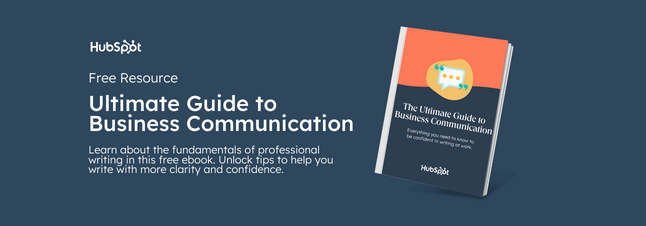And I'm not just talking about waiting too long to update a contact's information in your CRM. Seemingly innocuous phrases like, "Sorry to bother you," sneak into our regular sales emails and phone calls and poison our relationships without us even realizing it. Here's how to stop it.
Why You Should Never Say, "I Am Sorry for Bothering You"
Ideally, sales reps would never have to write a follow up email because they would avoid the number-one follow-up mistake: Failing to set a next step before ending the call.
All it takes is one cringeworthy phrase to kill a sales follow-up email. One of my least favorite moves is asking for a prospect to respond "ASAP." But apologizing for contacting your prospect is nothing short of poisonous to deals, and should be cut from the vocabulary of every sales rep. It usually looks like this:
Hey Mike,
Sorry to bother you again, but I wanted to make sure you received my last few emails with a great offer for our firewood package this winter.
I don’t want you to miss out on this opportunity. I know you’re busy, but I just wanted to touch base one last time.
All the best,
Annoying Allen

So, why should you avoid saying "Sorry to bother you again?”
- It implies you've become annoying to your prospect. It also reminds the prospect they’ve reached out several times before (“again”) to no success. Even if the sales rep hasn’t annoyed the prospect yet, this is the phrase that might do it.
- It implies you've done something wrong. In addition, people use the word “sorry" after doing something they deem wrong. When we make a mistake that negatively impacts someone, the first phrase that often comes out of our mouths is "I’m sorry." This phrase means we’ve acknowledged wrongdoing and know we need to fix it.
- It signals desperation. Reps send “sorry to bother you again” emails in hopes of starting a conversation after not hearing back. The message is a last-ditch effort to pique the potential buyer’s interest -- on the rep’s timeline.
- It communicates your time and energy is not as valuable as the prospect's -- which simply isn't true. Maintain authority and equal footing with your prospect by never apologizing for being in their inbox or voice mailbox.
If you find yourself using this phrase in an email -- stop writing. Instead, regroup and focus on providing value to the prospect and grabbing their attention instead of “bothering” them again.
There are a multitude of ways to provide value in a sales follow-up email. Here are a few I suggest.
Alternatives to Saying, "Sorry for Bugging You"
1. Send a customer review
A customer review provides value because modern-day buyers trust their fellow buyers to give honest feedback about a product they’ve used. Think they might not trust a written review coming directly from you?
Connect them with current and past buyers who can provide honest feedback on why working with you is great as well as some of the drawbacks. For example, you might open an email with, "Instead of sending you a pitch, I'll let a previous customer do the heavy lifting with their unvarnished (really) testimonial."
2. Include a case study
Case studies allow prospects to discover how a business in a similar position to theirs solved its problems. Send your latest and most relevant study with a note saying, "This case study made me think of your business. I know your time is valuable, and I think this is worth the few minutes it will take to read."
You've acknowledged their time is a priority for you, without discounting your own schedule and what you're offering.
3. Link to a blog post
A blog post is a way to build credibility with prospects and provide them new information about the product and company as they start to make a decision.
If you're trying to grab a prospect's attention, try sending one with an especially snappy title. You might even work with a marketer to craft a post just for them. After all, who isn't going to click the link to a post titled, "9 Reasons Julie Needs ABC Staffing Solutions Today."
4. Reference a mutual connection
Surfacing a mutual connection allows the prospect to ask their acquaintance about the sales rep and gather more information. It also signifies that if a friend works with this sales rep, the prospect might also enjoy working with the same sales rep.
And it gives you something in common to bond over. For example, "I see we have a mutual connection: Sansa Stark. Her family bought several dire wolves from me a few years ago." You've given your conversation and relationship something to build upon -- and that can be a huge help when conducting outreach.
5. Provide a suggestion
A small strategy tip can help sales reps build credibility and showcase the value of their insight to buyers.
When a salesperson’s name appears in a prospect’s inbox, the reaction shouldn’t be, “No, not this rep again!” or “Who?” but “I wonder what they’re sending me -- I better check it out.”
Send them a new industry benchmark report or a mention a recent move their company made, and offer unique insight into how your product/service could help.
For example, "I thought you might be interested in the latest benchmark report from [insert trusted industry source]. Their findings on the 25% increase in mobile app usage might be especially interesting to you and relevant to your work."
6. Drop shop-talk altogether
Want to really get their attention? Don't talk business at all. Instead, send them a casual email saying, "I watched a documentary on Colorado ski country this weekend and thought of you immediately. Have you hit the slopes yet this year?"
While your prospect might not be ready to discuss business -- most people like talking about their hobbies and out-of-office interests. Once you have them engaged again, use your best judgement to steer them back to the topic at hand: your offer.
7. Offer to walk away
If you've reached out multiple times over the course of several weeks or months and your prospect still hasn't responded, do yourself a favor and walk away.
You should be spending time on deals that actually have a chance of closing, and pleading with an unmotivated prospect to respond to your emails isn't doing either of you any good.
Simply say, "Tony, I've tried to reach you unsuccessfully a few times now. Usually when this happens, it means my offer isn't a priority for you right now. Is that safe for me to assume here? If so, you won't hear from me again."
If your prospect is still interested, this should grab their attention. If not, it gives them an easy way out. You can always leave the door open for a call or email six months down the line to see if things have changed.
8. Compliment them
If your prospect recently published a new blog post or the company unveiled a shiny, new product, let them know you're paying attention.
Chances are, they put a lot of time and effort into their recent project, and would love for someone to notice. Send a simple note saying, "I saw your recent feature in Forbes and wanted to tell you what a great write-up it was. I especially liked your observation that AI will begin to take a stronger hold in sales." It's short, specific, and complimentary.
Great emails build rapport and credibility. By looking for this deadly phrase before sending your emails, you can improve your odds of a response, and eventually, a relationship.
Want other ways to improve your sales emails? Check out these killer opening email lines or explore alternatives to saying, "Hope you're doing well" -- guaranteed to put your prospect to sleep before they've even read sentence two.
Sales Communication




![Active Listening Techniques To Use On Your Next Sales Call [+ Examples]](https://53.fs1.hubspotusercontent-na1.net/hubfs/53/active-listening-1-20250218-4164086.webp)
![How to Reply to a Sales Rejection Email From a Client [+ Templates]](https://53.fs1.hubspotusercontent-na1.net/hubfs/53/timing-objection-responses-1.jpg)




%20(1).png)

